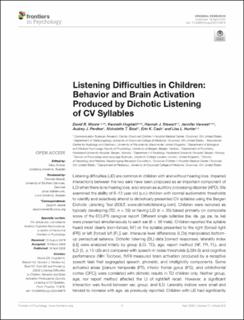| dc.description.abstract | Listening difficulties (LiD) are common in children with and without hearing loss. Impaired interactions between the two ears have been proposed as an important component of LiD when there is no hearing loss, also known as auditory processing disorder (APD). We examined the ability of 6–13 year old (y.o.) children with normal audiometric thresholds to identify and selectively attend to dichotically presented CV syllables using the Bergen Dichotic Listening Test (BDLT; www.dichoticlistening.com). Children were recruited as typically developing (TD; n = 39) or having LiD (n = 35) based primarily on composite score of the ECLiPS caregiver report. Different single syllables (ba, da, ga, pa, ta, ka) were presented simultaneously to each ear (6 × 36 trials). Children reported the syllable heard most clearly (non-forced, NF) or the syllable presented to the right [forced right (FR)] or left [forced left (FL)] ear. Interaural level differences (ILDs) manipulated bottom-up perceptual salience. Dichotic listening (DL) data [correct responses, laterality index (LI)] were analyzed initially by group (LiD, TD), age, report method (NF, FR, FL), and ILD (0, ± 15 dB) and compared with speech-in-noise thresholds (LiSN-S) and cognitive performance (NIH Toolbox). fMRI measured brain activation produced by a receptive speech task that segregated speech, phonetic, and intelligibility components. Some activated areas [planum temporale (PT), inferior frontal gyrus (IFG), and orbitofrontal cortex (OFC)] were correlated with dichotic results in TD children only. Neither group, age, nor report method affected the LI of right/left recall. However, a significant interaction was found between ear, group, and ILD. Laterality indices were small and tended to increase with age, as previously reported. Children with LiD had significantly larger mean LIs than TD children for stimuli with ILDs, especially those favoring the left ear. Neural activity associated with Speech, Phonetic, and Intelligibility sentence cues did not differ significantly between groups. Significant correlations between brain activity level and BDLT were found in several frontal and temporal locations for the TD but not for the LiD group. Overall, the children with LiD had only subtle differences from TD children in the BDLT, and correspondingly minor changes in brain activation. | en_US |

